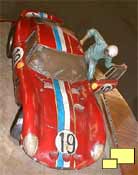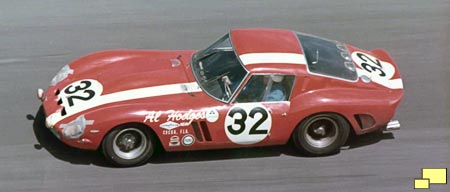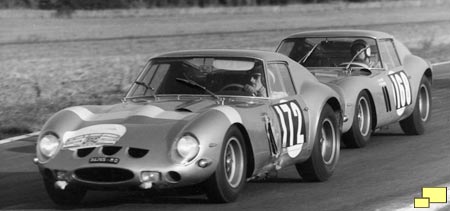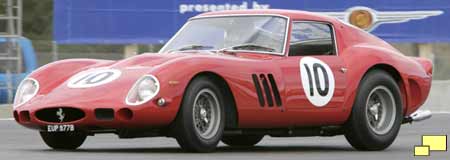
|
|
|
|
The Ferrari GTO lead two lives: one as a road car intended for public streets and the other as a full blooded competitive race car. It's primary purpose was to win races and it was quite successful in that endeavor.
1962, 1963 and 1964 were extremely successful years, with GTO wins adding up to Manufacturers Championship titles for all three years. If you were lucky enough to drive a GTO during those heady days, your competition was usually another GTO; it was not uncommon for half the field to be GTOs! Almost all were private entries, as the factory was focused on its formula one efforts, although they did provide support at major races.
|
|
|
|
Also impressive was the range of venues that the GTO made its mark. They competed in Africa, Europe, the Caribbean and North America, in events as diverse as hill climbs (very popular in the 60s), endurance races (LeMans, Daytona and Sebring), rallies (including off-road) and sprints.
|
|
|
|
|
|
|
s/n 3647 (#27) and s/n 4725 SA (#6)
|
|
|

1962
Not a full season, as 1962 is the first year the Ferrari GTO was available. It competed 106 times in 49 races. The GTOs dominated with 41 class wins and 25 overall wins. Roger Penske, well known for his Indy 500 successes, is credited with two of the class and overall victories. Six cars were entered at LeMans, and three took first, second and third in their class.
|
|
|
|
|
|
s/n 3387 GT at the 12 hours of Sebring, driven by Phil Hill and Olivier Gendebien on March 24, 1962. Result: first in class, second overall.
|
|
|

1963
Competition became serious with special light weight Jaguar E-Types and Chevrolet Corvettes as well as Carroll Shelby and his AC Cobras. With more GTOs available, they competed 188 times in 107 races. There were 73 class wins and 22 overall wins; highlights included a one, two, three repeat of 1962's class win at LeMans.
|
|
|

1964
Although they won the manufacturers title for Ferrari, The GTOs dominance was starting to wane as the Ford Cobra and other factory efforts escalated. Controversy surrounded the season with debates over the qualifications of the cars. Ferrari's focus started to switch to their prototype cars, which clearly had more potential. Ferrari GTOs, entered 237 times in 139 races, managed 85 class wins and 28 overall wins.
|
|
|
Ferrari 250 GTO, s/n 3223 GT, Daytona 2000 Kms, 16 February 1964, Perkins/Eve, 11th OA. Photo by Chuck Rogers.
The NASCAR-style advertising on a GT Ferrari was highly controversial in that period, influenced as it was by many "gentleman drivers", and it prompted a vigorous protest from other Ferrari competitors. Although not used again after this race, the sponsorship logo had long-term consequences for the owner, Larry Perkins, in terms of technical assistance, parts access and preparation for subsequent events.
|
|
|
|

|
|
|
|
GTO s/n 4153 (No. 172) and s/n 5111 (No. 168) at the Tour de France Automobile Race on September 11, 1964. In this formation, they took overall first and second respectively. The drivers for No. 172 were Lucien Bianchi / Georges Berger and Jean Guichet / Prince Michel de Bourbon Parme for No. 168.
|
|
|

1965
The GTOs last big win was in May at Targa Florio in Italy. The GTO had the honor of being one of the last significant front engined race cars; by the mid 60's the mid engine configuration was clearly more competitive. They continued to compete and win under private efforts, a testimony to their desirability, soundness of design and the loyalty of their owners and race fans.
|

|
|
|
|
|
|
|
Ferrari GTOs line up for a family reunion photo at the Monterey Historics race on August 2004. Approximately 20 GTOs were in attendance, just like the good old days!
|
|
|
|
These days they are commonly seen in vintage racing events which are extremely popular as well as an honorable retirement venue for one of the most exceptional race or street cars ever produced.
|
|
|
|

The safety record for the Ferrari GTO, considering the times, was good but not perfect. One driver, Henri Oreiller, was killed in a Ferrari GTO. It happened on October 7, 1962 at the Coupes Salon at Montlhery, France. The accident occurred at the start of the race with the fact that the seatbelt was not in use as a contributing factor.

The Competition
|
|
|
The competitive decline in the Ferrari GTO was due in part to a shift in regulations which pitted them against Ford Cobras and (above) Cobra Daytona Coupes. The Cobras ran seven liter engines (the Cobra Daytona Coupes were equipped with 4.7 liter motors) and no amount of driving skill or chassis superiority could make up for the disadvantaged 3.0 liter engines in the GTOs.
If you're looking for a quality racing blog, we can recommend The Voodoo Images Blog.
|

|
Great cars can inspire great art. This 1988 piece by J. Paul Nesse, entitled "Le Dupart du Mans", depicts driver Jean Guichet taking over from co-driver Pierre Noblet in Ferrari GTO s/n 3705 GT during the 1962 Le Mans race. The team went on to finish first in their class and second overall. 3705 GT survives today (see below) with it's original Le Mans colors.
|
|
|
|
|















